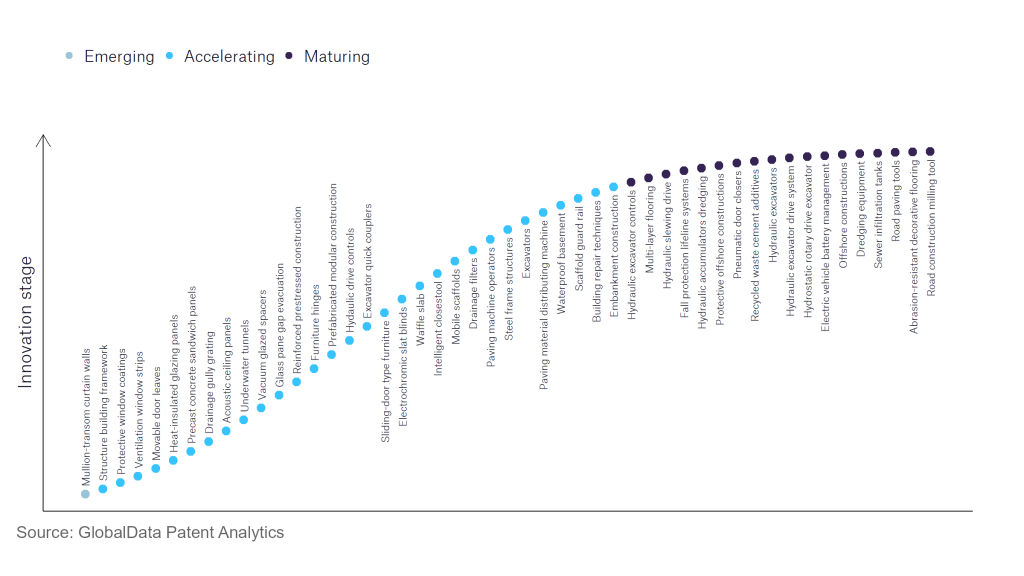The construction industry continues to be a hotbed of innovation, with activity driven by an increased focus on environmental sustainability and workplace safety, and the growing importance of technologies such as the Internet-of-Things (IoT) and robotics as well as higher quality construction products and materials. In the last three years alone, there have been over 248,000 patents filed and granted in the construction industry, according to GlobalData’s report on Innovation in Construction: Acoustic ceiling panels. Buy the report here.
However, not all innovations are equal and nor do they follow a constant upward trend. Instead, their evolution takes the form of an S-shaped curve that reflects their typical lifecycle from early emergence to accelerating adoption, before finally stabilising and reaching maturity.
Identifying where a particular innovation is on this journey, especially those that are in the emerging and accelerating stages, is essential for understanding their current level of adoption and the likely future trajectory and impact they will have.
80+ innovations will shape the construction industry
According to GlobalData’s Technology Foresights, which plots the S-curve for the construction industry using innovation intensity models built on over 179,000 patents, there are 80+ innovation areas that will shape the future of the industry.
Within the emerging innovation stage, mullion-transom curtain walls is a disruptive technology that is in the early stage of application and should be tracked closely. Heat insulated glazing panels, drainage gully grating, and acoustic ceiling panels are some of the accelerating innovation areas, where adoption has been steadily increasing. Among maturing innovation areas are abrasion-resistant decorative flooring, and road construction milling tools, which are now well established in the industry.
Innovation S-curve for the construction industry

Acoustic ceiling panels is a key innovation area in construction
Acoustic ceiling panels insulate rooms from unwanted noise by absorbing sound from both inside and outside the room, creating a more pleasant environment for the occupants. A growing desire for better acoustic performance, particularly in schools and offices, will drive innovation in this space to improve the acoustical properties of ceiling panels.
GlobalData’s analysis also uncovers the companies at the forefront of each innovation area and assesses the potential reach and impact of their patenting activity across different applications and geographies. According to GlobalData, there are 30+ companies, spanning technology vendors, established construction companies, and up-and-coming start-ups engaged in the development and application of acoustic ceiling panels.
Key players in acoustic ceiling panels – a disruptive innovation in the construction industry
‘Application diversity’ measures the number of different applications identified for each relevant patent and broadly splits companies into either ‘niche’ or ‘diversified’ innovators.
‘Geographic reach’ refers to the number of different countries each relevant patent is registered in and reflects the breadth of geographic application intended, ranging from ‘global’ to ‘local’.
Patent volumes related to acoustic ceiling panels
Source: GlobalData Patent Analytics
A leading company in the acoustic ceiling panels space is Knauff. The company, which has a significant market share in the global wallboard industry, is increasingly providing wall and ceiling panel products with greater acoustic performance and variation in design. A recent innovation is the use of modified gypsum panels to create a monolithic ceiling with strong acoustical properties, allowing for more variation in design compared to the standard use of gypsum panels which requires a suspended grid to hold individual panels. The modified gypsum panel can be made by perforating standard sheets of drywall and then covering the perforated sides of the sheet with additional laminated sheets or layers. Other leading companies in the acoustic ceiling panel space are Fujifilm, Compagnie de Saint-Gobain, BASF and Liaver.
By application diversity, leading companies include CertainTeed Gypsum and Louisiana Pacific. In terms of geographic reach, Saint Gobain Performance Plastics and BASF are among the leading companies.
To further understand the key themes and technologies disrupting the construction industry, access GlobalData’s latest thematic research reports on Construction.
Data Insights
From

The gold standard of business intelligence.
Blending expert knowledge with cutting-edge technology, GlobalData’s unrivalled proprietary data will enable you to decode what’s happening in your market. You can make better informed decisions and gain a future-proof advantage over your competitors.



